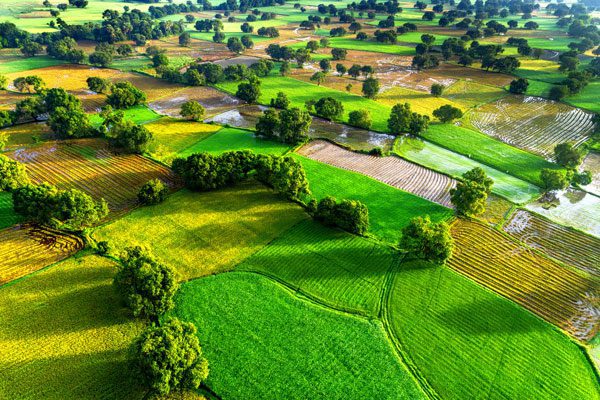In my work as an agriculture consultant, I make the argument all the time that the way we are growing and eating food is the central problem that we face in the world today.
It is no small statement. Indeed, issues ranging from hunger and environmental toxicity to health care and climate change can be positively impacted by finding points of collaboration within and between our diet, the way we grow food, and the way we approach public health.
What Is Agriculture?
The challenge that we face is that our decision-making processes have been siloed and calibrated linearly, and we cannot solve dynamic problems with linear, compartmentalized thinking. The answers and solutions lie in a systems-based approach that seeks resonance within and between human and natural living ecosystems and implements strong incentive between the spheres of food, farming, and human health.
Agriculture is about so much more than growing crops. It is also the distribution system that delivers food to the market; all of the food products manufactured and sold around the world; the restaurant that is serving food, and the eating. The great Wendell Berry reminds us, “Eating is an agricultural act“.
Collectively, we are further away from the sources of agriculture than at any time in human history. Food travels a long way, and the majority is manufactured out of sight and out of mind. When we are not involved in preparing our food, and we are not communicating our concerns through our votes and our food choices, we get what we got – an artificial, corporate agricultural system compromised for common sense.
A Changing System
Over the last century, the way food is grown and eaten has been altered by corporate interests that consolidate wealth, patent life forms, and put profit before people. It disrupts the global economy and undermines the fundamental public trust in government. Our policies don’t reflect what we would want if we were asked. We are trying to make things better, but we are actually making things worse, and this is now obvious to the average person. In simple terms, we need new ways of doing things.
Rural communities and farm-based economies are collapsing, food and water are toxic and no longer our medicine, and the general public is in the midst of widespread and growing epidemics of chronic disease, hunger, malnutrition, and more. Conventional Agriculture is destroying the very fabric of life – the soil food web – and it is devastating the microbiome in our gut that, in turn, is undermining our health, the social landscape, and the future of our species.
Searching For Answers
The answers live in agriculture. Regenerative Agriculture utilizes methods like no-till farming and using cover crops for living roots. It recognizes natural rhythms and builds processes around them, manages for diversity and balance, and focuses on nutrient density. Most importantly, it brings the intention of using less to get more and a perspective and reverence for dynamic living systems that need to be nurtured, not controlled.
Through the implementation of Regenerative Agriculture, we can improve farmer profitability, reduce environmental toxicity, and clean our waterways. We can also generate higher nutrient density in food capable of improving public health, begin to sequester carbon in the soil to address climate change, and, in the process, grow thriving people—all while growing food.
A new approach to agriculture can fix big problems. There is no more potent way to bring a positive impact to the challenges that we face than seriously engaging Urban and Regenerative Agriculture. What we need are public buy-in and political will.
How We Can Do It
One strategy is to implement high-level Urban Agriculture projects in cities and counties all over the country and establish a Farm Core that motivates the youth to participate in agriculture in return for good incentives. We need a real effort to bring agriculture to the people. There are now “teaching farms” popping up all over the country integrating educational farming with entrepreneurship where kids grow crops for school cafeterias. Some teaching farms are even integrating mental health engagement, community gardens, and economic development.

Conventional Agriculture is failing both urban Democrats and rural Republicans, voter turnout is dismal, and people in all parts of the urban/rural divide are struggling to make ends meet. Agriculture is a uniquely positioned political issue that positively impacts both rural and urban communities and represents a real opportunity to generate a political consensus that crosses party lines.
Politics rarely leads, so we must educate ourselves and get organized to hold our elected officials accountable. The agricultural solutions at hand are not politically divisive issues; they are potent political opportunities. Politicians who educate themselves and work to inform the general public of these insights and opportunities will be in a position to bring people together.
Changing The Mindset
The way we are doing agriculture now is not working. If we think about agriculture as an organism, the vital organs of food, farming, and human health have been compromised, and, like cancer, are operating without communication to the rest of the agricultural organism.

The agricultural landscape is being dictated by money, not nourishment, which leaves half the world starving, and the other half trying to lose weight. Agriculture has lost touch with equitable priorities.
The majority of food eaten in the United States is processed. Chemicals have been added in an effort to enhance or preserve the food product so that it has more marketability and does not spoil. When we alter food in this way, it diminishes the nutritional value, and when combined with the toxins from chemical agriculture and the sugars and additives used in food chemistry, the result is empty, toxic food that does a poor job of nourishing people.
It’s All Connected
This reality is at the root of our public health crisis, but it is also a result of inferior farming methods. Higher crop yields can be achieved using synthetic fertilizers and pesticides, but the petrochemicals used to manufacture them are getting more expensive and doing environmental damage. Weed and pest resistance means farmers are either using more of them to achieve these yields or switching to new, more costly chemicals. When it comes to the performance and value of agriculture, the answer is not in heavier artillery.
In Conventional Agriculture, we take this assault on Mother Nature to another level with genetically modified organisms (GMO) designed to withstand the application of broad-spectrum synthetic pesticides and herbicides. Even if genetic engineering was a good idea, it is resulting in a massive increase of these biocides being sprayed globally with an untold negative impact on public health.
The man-made farming practices championed by industrial agriculture and baked into the Conventional Agriculture system leave farmers stuck in a rut of cultural and chemical dependency, with no effective social or economic safety net to help them climb their way out and get ahead. For context, based on the most recent CDC data, the suicide rate for male farmers is double that of veterans.
Given the reality of how we are eating and growing our food, marketing plays a big part in agriculture. Trillions of dollars are spent annually by corporations and industry to convince eaters to purchase from them. Unfortunately, the focus is more on how to confuse and manipulate the eater than it is on how to inform. What happens when the word “natural” does not mean natural? Consider why we drink orange juice in the morning or a sandwich for lunch?
The Conventional Agriculture industry – including Fast Food, Big Ag, and Big Pharma – is capitalizing on a confused market and generating record profitability through farm consolidation, parasitic land practices, synthetic agronomy, food science, and effective branding. All of this is supported and subsidized by the federal government. We are feeding plants and ourselves food products that Dr. Vandana Shiva calls “fake cheap”, then attempting to manage our agricultural and human health symptoms with chemicals so that we can use and eat more of the food products. It is a vicious cycle.
We Can Do It
There is hope. The public health crisis that we are experiencing as a result of artificial farming and empty food is forcing millions of people to rethink the conventional diet, and the agricultural industry is poised for transformational change. When people start eating differently, farmers start farming differently, and, ultimately, politicians start making different decisions.
Our social order is written by narrative and incentive; if we can tell the true story and motivate the right actions, we can change the big problems for the better. We can do this by recognizing that we all have a seat at the table of agriculture; we are all capable of making an impact.
Rather than excuse or resist these changes to the status quo, we must embrace them, and move our politics and social order to new norms by bringing this story of food, farming, and human health to the mainstream. Only then can we start moving mouths and minds in new directions and change the world for the better.